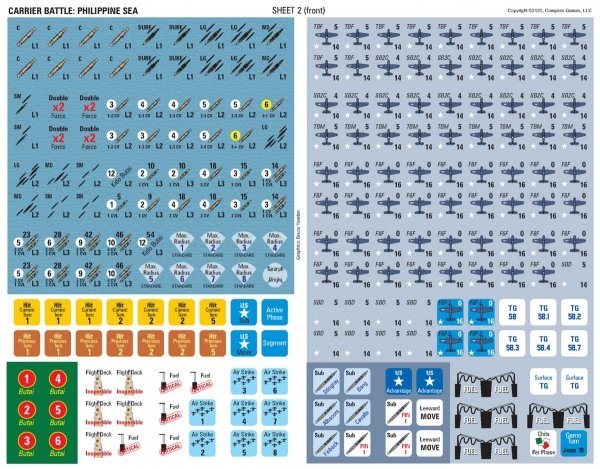-
Załączniki bezpieczeństwa
Załczniki do produktuZałączniki dotyczące bezpieczeństwa produktu zawierają informacje o opakowaniu produktu i mogą dostarczać kluczowych informacji dotyczących bezpieczeństwa konkretnego produktu
-
Informacje o producencie
Informacje o producencieInformacje dotyczące produktu obejmują adres i powiązane dane producenta produktu.Compass Games
-
Osoba odpowiedzialna w UE
Osoba odpowiedzialna w UEPodmiot gospodarczy z siedzibą w UE zapewniający zgodność produktu z wymaganymi przepisami.
Carrier Battle: Philippine Sea is a solitaire simulation of the largest carrier battle in history, fought during the invasion of Saipan (June, 1944). As the U.S. commander, you maneuver your task forces and conduct air searches in a tension-packed contest to find the Japanese carriers before they locate and attack yours. Simple game mechanics control Japanese movement and determine the timing and strengths of their attacks. You will not know that a Japanese air strike is headed your way until it is detected by radar and you scramble your fighters to intercept.
The game has a total of nine scenarios. Four learning scenarios take you through the rules by programmed instruction using slices of the real battle. The other five are full-scale, fully replayable games. These include one-day scenarios for each day of the action, a two-day scenario for the whole battle, a hypothetical scenario presuming different US plans, and a hypothetical scenario in which Midway was never fought and the Japanese come armed with the full Pearl Harbor striking force.
Carrier Battle: Philippine Sea includes a hexagonal map of the area of ocean where the battle was fought, at a scale of 33 nautical miles per hex. The mapsheet also includes player displays for US task groups and air missions. One complete game turn represents 80 minutes of real time, divided into four Action Phases of 20 minutes each. There are 528 die-cut counters representing individual capital ships, groupings of smaller ships, air units of approximately 8-12 aircraft each, and informational markers. Other play aids include Japanese force (“Butai”) displays, a charts and tables booklet, a game-turn flow chart, and a Japanese air raid decision flow chart.
Carrier Battle: Philippine Sea is based on Carrier (Victory Games, 1990) but is a new, standalone game.
Product Information:
- Complexity: Low to High (programmed instruction from initial scenarios to full campaign)
- Time Scale: 80 minutes per turn (four identical 20-minute action phases per turn)
- Map Scale: 33 nautical miles per hex
- Unit Scale: individual capital ships, small groups of smaller ships, 8-12 aircraft
- Players: One (solitaire game)
- Playing Time: several minutes for training scenario up to several hours for full campaign
- Solitaire Suitability: Perfect (designed for solitaire play)
Components:
- 1 Mounted map
- 2 Countersheets (528 9/16″ inch playing pieces)
- 1 Rulebook
- 1 Charts and Tables booklet
- Multiple Player aid cards
- 10-sided die
- Box and Lid
Game Credits:
- Designer: Jon Southard
- Artist: Bruce Yearian



















